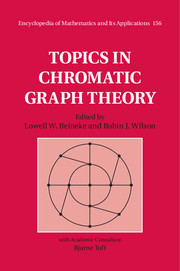Book contents
- Frontmatter
- Contents
- Foreword
- Preface
- Preliminaries
- 1 Colouring graphs on surfaces
- 2 Brooks's theorem
- 3 Chromatic polynomials
- 4 Hadwiger's conjecture
- 5 Edge-colourings
- 6 List-colourings
- 7 Perfect graphs
- 8 Geometric graphs
- 9 Integer flows and orientations
- 10 Colouring random graphs
- 11 Hypergraph colouring
- 12 Chromatic scheduling
- 13 Graph colouring algorithms
- 14 Colouring games
- 15 Unsolved graph colouring problems
- Notes on contributors
- Index
- References
3 - Chromatic polynomials
Published online by Cambridge University Press: 05 May 2015
- Frontmatter
- Contents
- Foreword
- Preface
- Preliminaries
- 1 Colouring graphs on surfaces
- 2 Brooks's theorem
- 3 Chromatic polynomials
- 4 Hadwiger's conjecture
- 5 Edge-colourings
- 6 List-colourings
- 7 Perfect graphs
- 8 Geometric graphs
- 9 Integer flows and orientations
- 10 Colouring random graphs
- 11 Hypergraph colouring
- 12 Chromatic scheduling
- 13 Graph colouring algorithms
- 14 Colouring games
- 15 Unsolved graph colouring problems
- Notes on contributors
- Index
- References
Summary
This chapter is concerned with chromatic polynomials and other related polynomials: flow polynomials, characteristic polynomials, Tutte polynomials and the Potts model partition function. We describe their basic properties and state some recent results and open problems. We also outline some techniques for working with these polynomials.
Introduction
The study of chromatic polynomials of graphs was initiated by Birkhoff [3] in 1912 and continued by Whitney [49], [50] in 1932. Inspired by the four-colour conjecture, Birkhoff and Lewis [4] obtained results concerning the distribution of the real zeros of chromatic polynomials of planar graphs and made the stronger conjecture that they have no real zeros greater than or equal to 4. Their hope was that results from analysis and algebra could be used to prove their stronger conjecture, and hence to deduce that the four-colour conjecture was true. This has not yet occurred: indeed, the four-colour conjecture is now a theorem, but the stronger conjecture of Birkhoff and Lewis remains open. Nevertheless, many beautiful results on chromatic polynomials have been obtained, and many other intriguing questions remain unanswered.
Work on chromatic polynomials has received fresh impetus in recent years from an interaction with mathematical physics. The chromatic polynomial is a specialization of the Potts model partition function, used by mathematical physicists to study phase transitions. A combination of ideas and techniques from graph theory and statistical mechanics has led to significant new results on both polynomials. Other recent progress has been made through the use of techniques from algebraic geometry to solve a long-standing open problem concerning the coefficients of chromatic polynomials.
Definitions and elementary properties
All graphs considered are finite and (unless stated otherwise) without loops or multiple edges. As usual, we use G − e to denote the graph obtained by deleting an edge e from a graph G and G/e the graph obtained by contracting e.
- Type
- Chapter
- Information
- Topics in Chromatic Graph Theory , pp. 56 - 72Publisher: Cambridge University PressPrint publication year: 2015
References
- 3
- Cited by

